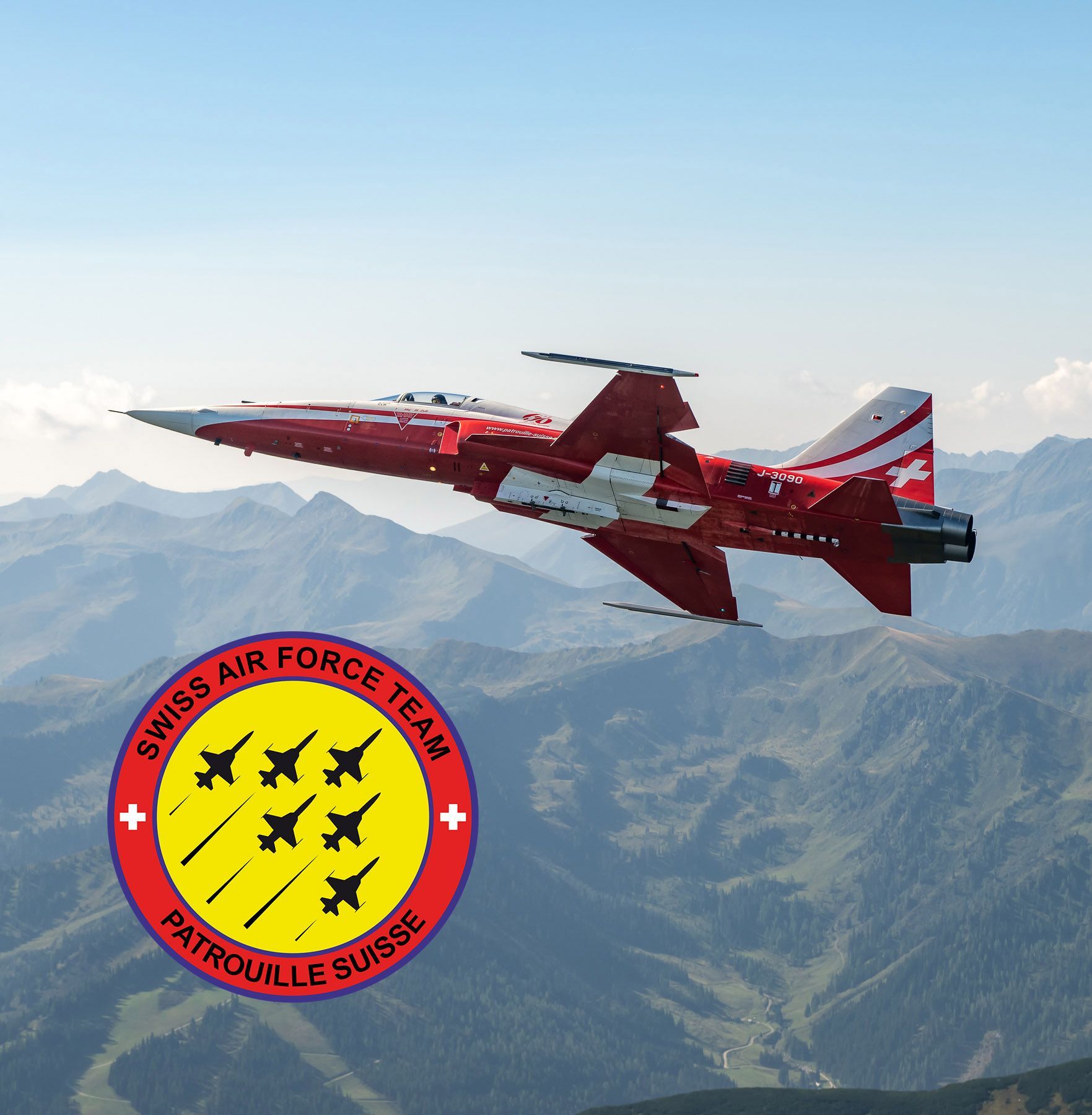The year 2024 saw the 60th anniversary of a European military jet demonstration team. Indeed, the famous Red Arrows were established in 1964 as well, but in this article we are focusing on Patrouille Suisse, the Swiss Air Force precision flying formation.
Text and photos: Emiel Sloot
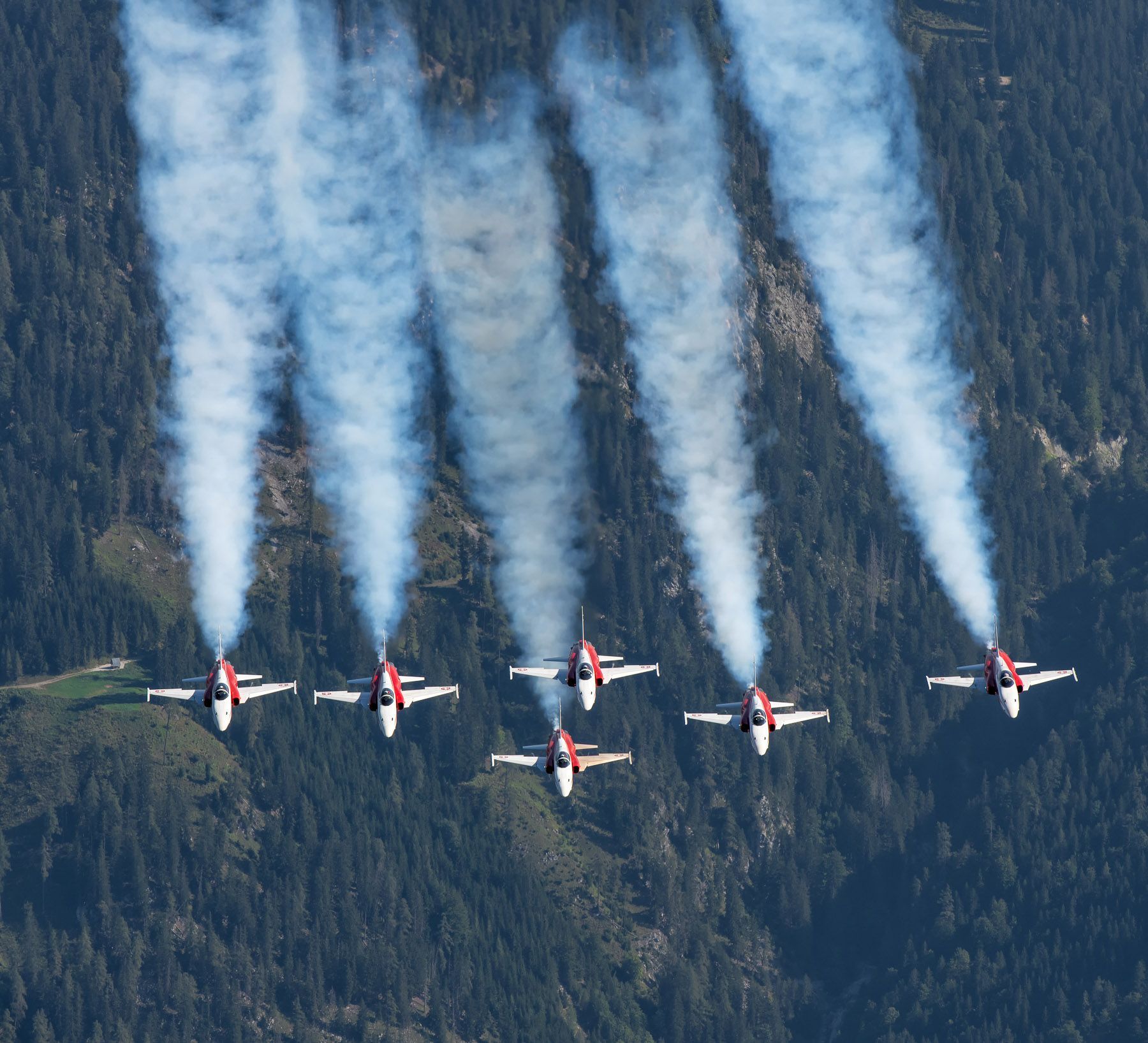
Anniversary season
Adorned with special ‘60’ markings, the red/white Northrop F-5E Tiger IIs of Patrouille Suisse pleased the crowds at airshows in Portugal, the United Kingdom, Austria and Belgium. The Airspirit 24 that was planned for August 2024 at the team’s home base Emmen should have been the team’s main celebration event, with several other teams attending. However, along with the annual Axalp demo, the air force was forced to cancel this show for budgetary reasons. And there are more dark clouds on the horizon, as the team’s future is uncertain with the F-5Es now rapidly approaching the end of their service life in Switzerland.
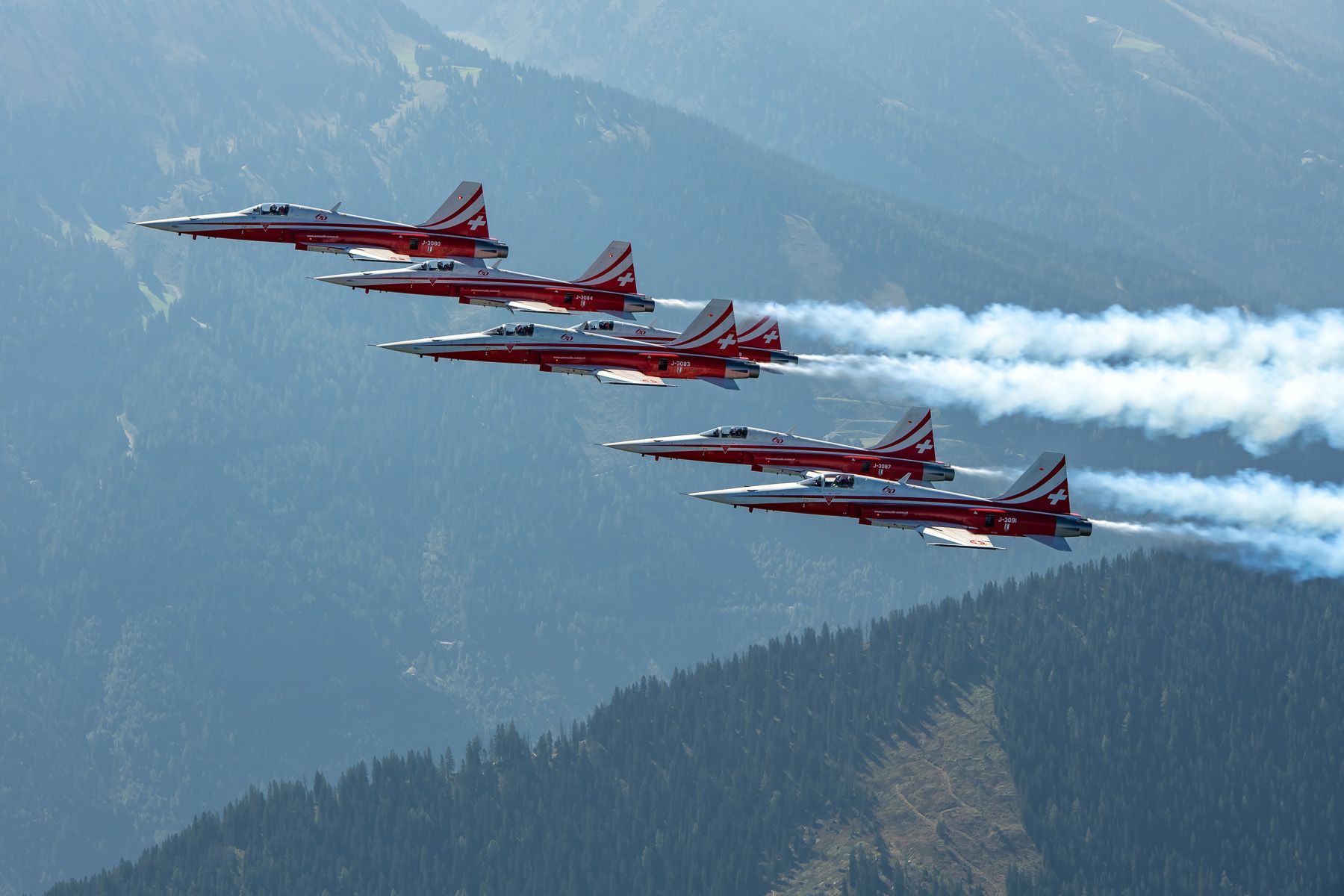
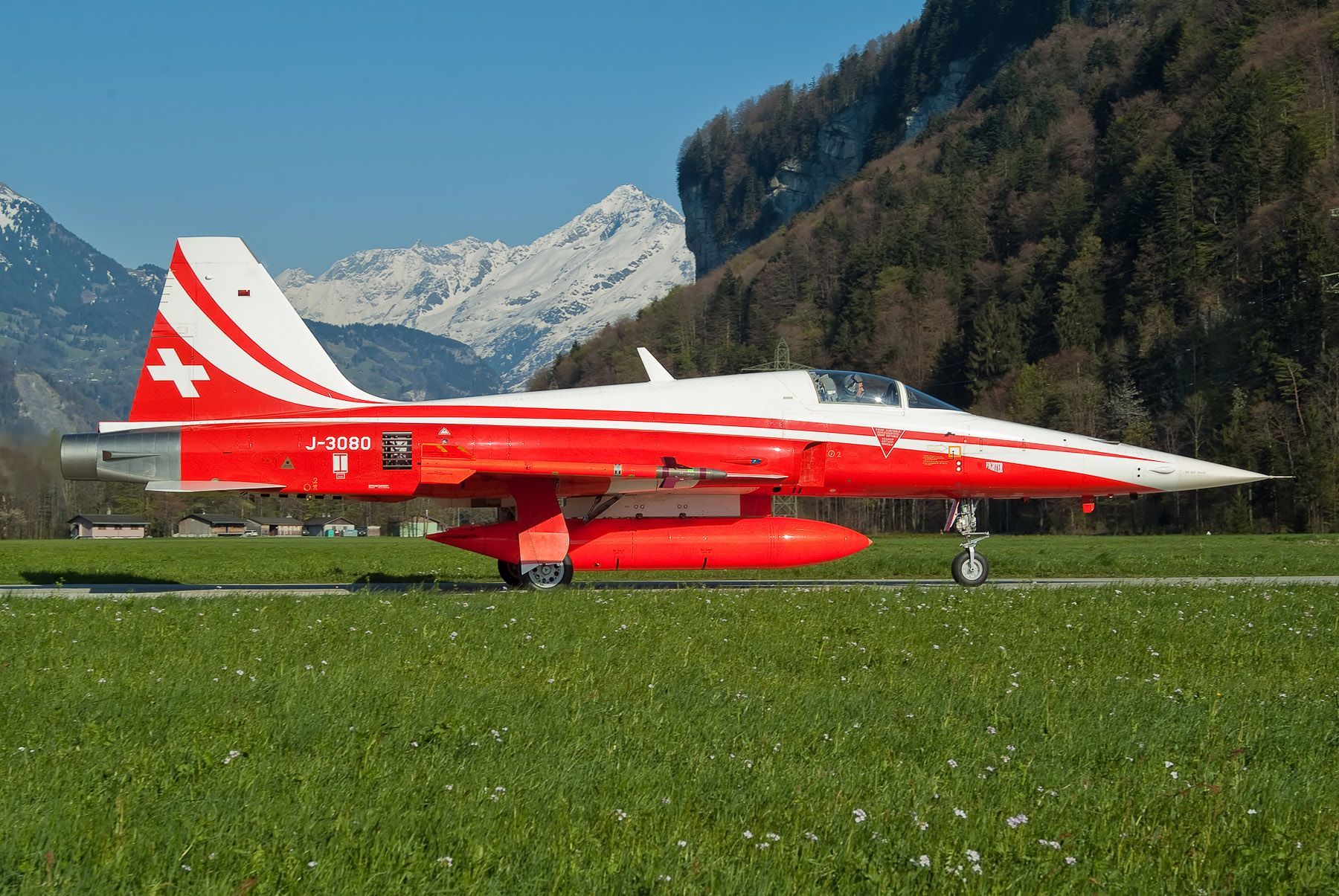
The early days
So how did it all start with this long-standing team? Let’s go back to 1964 to find out.
In the mid-1960s, the Swiss Air Force was equipped with large numbers of jet fighters of British origin, being the De Havilland Vampire and Venom as well as the Hawker Hunter. Regarding the latter, 12 ex-Royal Air Force F Mk.6 and 88 new-built F Mk.58 had been delivered from 1959. These equipped two squadrons of the Überwachungsgeschwader or Air Surveillance Wing, as well as three part-time militia squadrons that would be fully activated in times of crisis. At a later stage, 60 additional Hunters (52 F Mk.58As and eight T Mk.68 trainers) would be taken on charge.
In 1964, the Expo 64 World Fair was organised by host city Lausanne. This national exhibition, along with the Swiss air force’s 50th anniversary in the very same year, sparked the idea within the air arm command to form a team for a formation demo to highlight these events. The thought to create such a team was not new, as already in 1959, the Überwachungsgeschwader received a task to form a Hunter four-ship for display purposes.
After the plan was approved, things took shape and on 22 August 1964, Patrouille Suisse was born. The name was largely inspired by their neighbours where Patrouille de France did similar performances for more than a decade already, being officially established in 1953. Since the Swiss Federal Military Department appreciated the idea of flight demonstrations for a larger public, the Expo 64 would not turn out to be a one-off exposure and Patrouille Suisse could plan on a season the next year that would consist of four air shows over Switzerland, displaying their four Hunters.
From then on, constant improvements would fine-tune the team in several ways such as their manoeuvres and number of aircraft. For example, in 1970 a fifth Hunter was added. Unlike their international fellow demo teams, Patrouille Suisse used Hunters loaned from the day-to-day roster that were painted in the regular day fighter camouflage pattern.
In 1968, the newly acquired Mirage IIIS had to be shown for the general public. The type was actually considered to be used by the team and two displays by the Patrouille de Suisse Mirage were indeed flown, however for the future the good old Hunter proved to be the preferred choice.
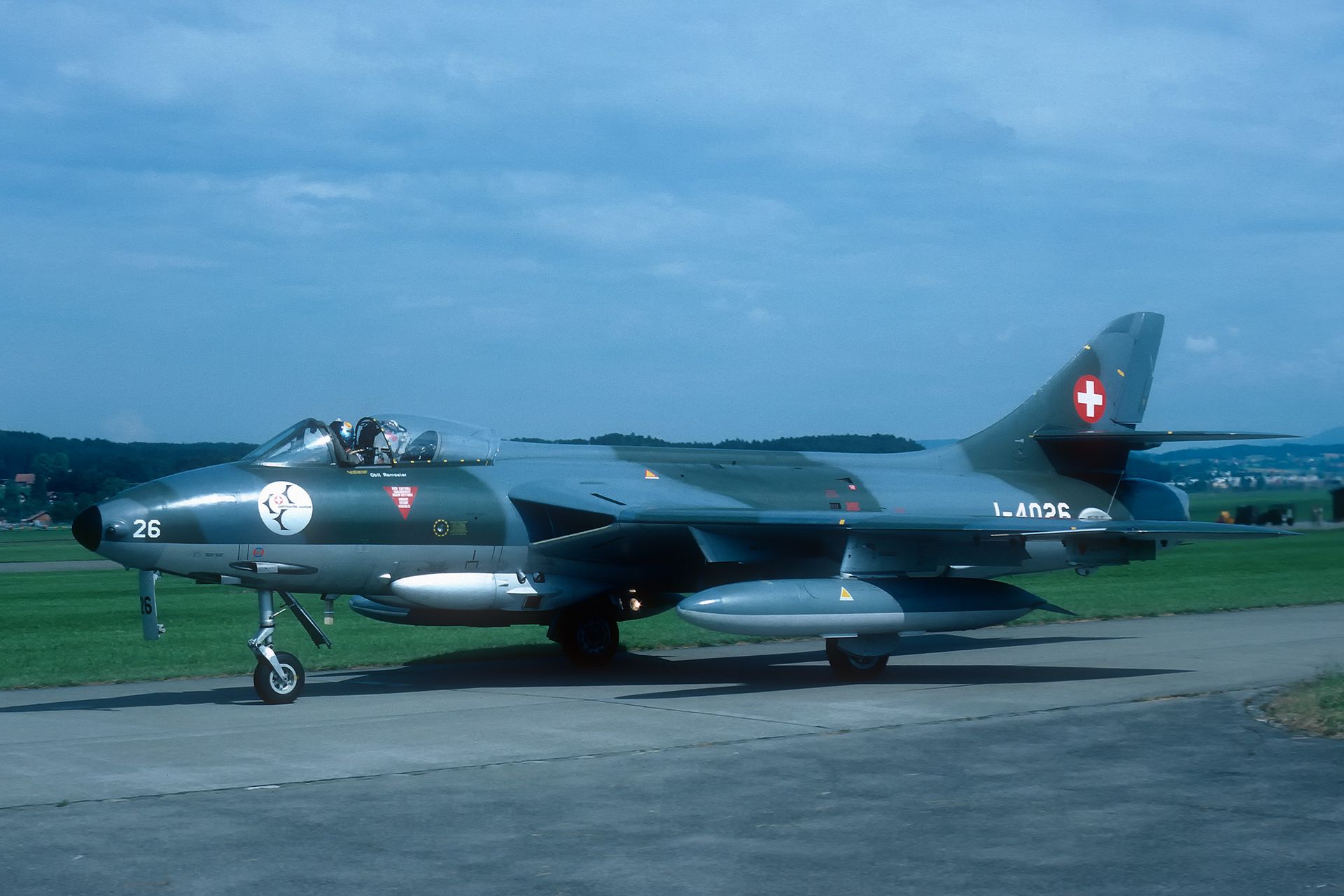
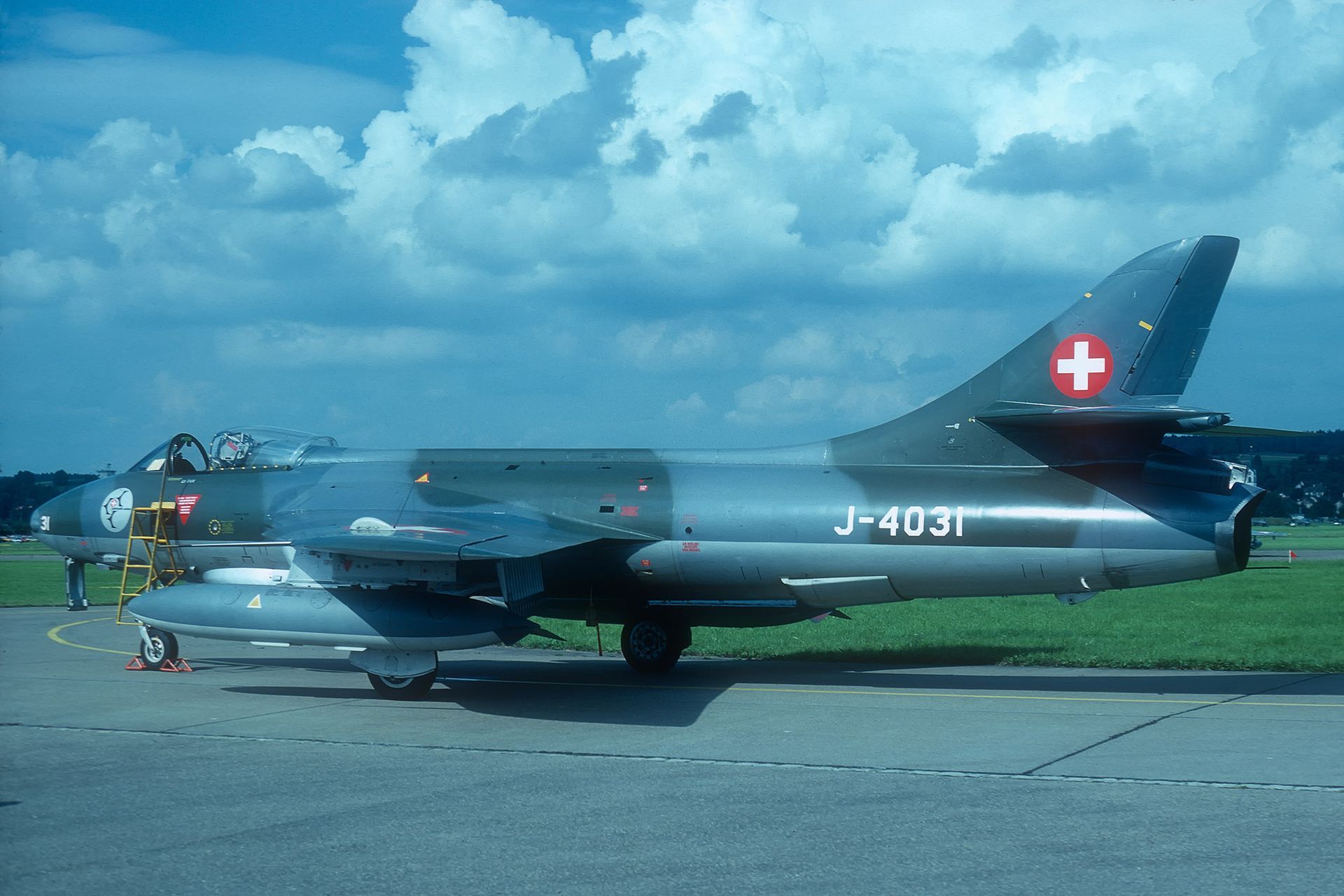
Going international
Initially, displays were limited to Swiss territory as because of the country’s strict neutrality policy, the team was not allowed to show their skills beyond the border. The main annual event was the AMEF Flugmeisterschaft at Dübendorf, where the various air force squadrons could measure their skills in a competition after which the event finished with a few air demonstrations. However, 1978 saw the team’s first international gig as they were invited to attend the 25th anniversary of Patrouille de France at their home base Salon-de-Provence. Shortly before, a sixth aircraft had been added to the formation and this amount would be maintained until present day. The team could now also make use of a smoke system fitted to the Hunters the year before.
Showing abroad tasted like more and in 1979 they attended the International Air Tattoo at RAF Greenham Common. This was not without success as they won the Shell Trophy for the best overall flying demonstration.
During the early 1990s, Swiss Hunters still equipped several militia squadrons. However, as international tensions had significantly decreased following the end of the Cold War, their days would be numbered. For quite some time, Patrouille Suisse had used twelve dedicated airframes (serialled J-4020 to J-4032 except J-4024), with a large team badge on the forward fuselage. Although the type would be withdrawn soon, the team’s Hunters were partially repainted in 1991 with the underside displaying the Swiss flag. The reason for this new outfit was the 700th anniversary of the Helvetic Confederation.
While being based at Dübendorf since its establishment, the team moved to Emmen on 3 July 1992. Two years later, the curtain fell for the Swiss Hunter fleet. According plans laid down in a large reorganisation programme know as Armee 95, the type would be retired by the end of 1994. As a result, that would also be the final Hunter year for Patrouille Suisse. Since the team celebrated their 30th anniversary in 1994 as well, their aircraft were specially marked as such.
Although no relation to the team, it is noteworthy to mention that a large number of former Swiss air force Hunters were sold abroad and many of these are still flying around today, ranging from historic aviation organisations to companies deploying former Swiss Hunters for adversary training. It clearly marks not only the ruggedness of the design, but also the fact that these aircraft have been very well maintained by their former owners.
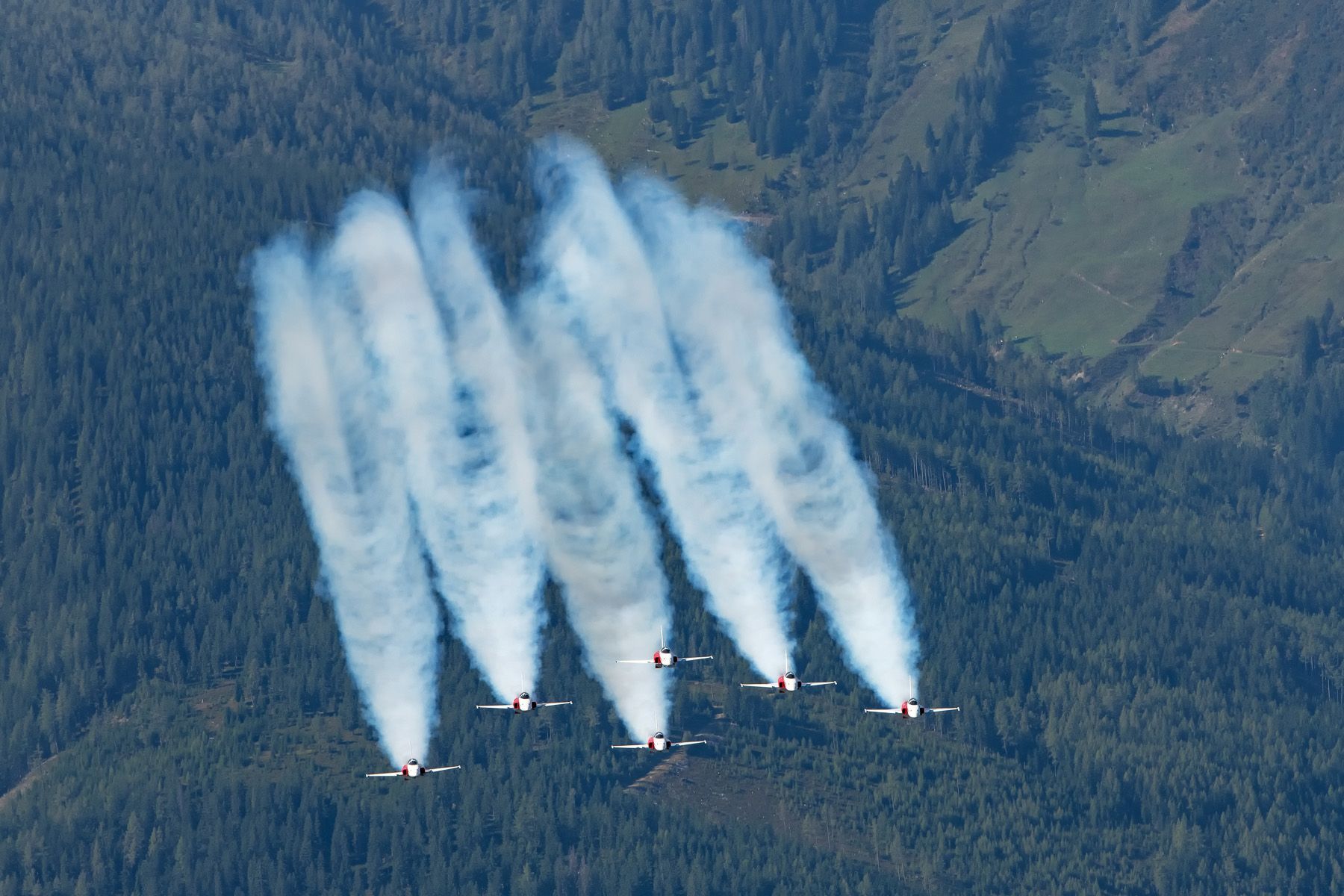

New equipment
From early 1995, Patrouille Suisse re-equipped with the Northrop F-5E Tiger II. A total of 110 aircraft (98 F-5E and 12 F-5F dual-seat trainers) had been acquired in two batches and delivered between 1978 and 1985. A detailed report on the Swiss F-5 Tiger was completed earlier by the author and can be found here. Similar to the Hunter days, twelve F-5Es that were part of the second Peace Alps II contract (serialled J-3080 to J-3091) would be assigned to the team. However, unlike their predecessor, these Tigers would be completely sprayed in a red/white colour scheme. Like their Hunters, provisions for a smoke system were installed to give the display an extra dimension, although two (J-3080 and J-3089) would not be adapted as such, acting as backup airframes in case one of the regular examples would be unavailable. For the modified aircraft, eight diesel smoke systems are available that can be removed in case the airframes are used for regular day-to-day operations with the Swiss air force such as target towing.
In the six-ship configuration, Patrouille Suisse would successfully continue their performances over Switzerland and abroad, resulting in many highlights. At the Royal International Air Tattoo 2000, occasionally held at RAF Cottesmore due to reconstruction works at the RIAT’s home base Fairford, Patrouille Suisse was awarded the King Hussein Memorial Sword for the best performance following a perfect display. In 2004, the anniversary year for both the team (40 years) and the Swiss air force (becoming 90), the large Air04 airshow was organised at Payerne. This event featured aerobatic teams from four countries (Red Arrows, Frecce Tricolori, Patrulla Aquila and Team 60) that joined Patrouille Suisse in an impressive show. The 2012 tour around Scandinavia posed a logistical challenge, with the team’s seven aircraft and two trucks full of support equipment travelling through the region in less than three weeks, with the midnight display as part of the Midsummer night Airshow over Kauhava, Finland as the ultimate highlight. The team’s 50th anniversary in 2014 formed the theme for that whole season, built around the Air14 airshow at Payerne.
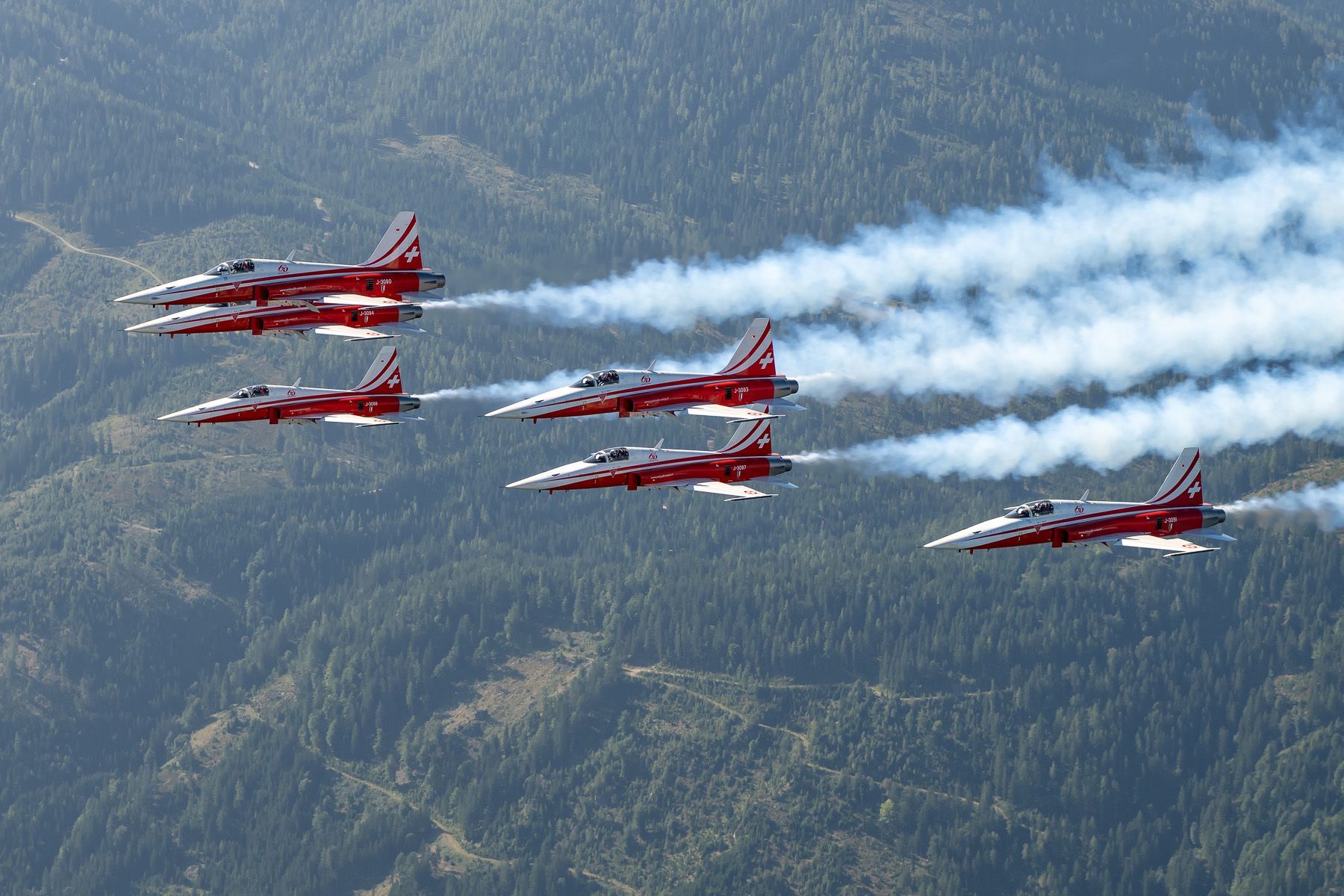
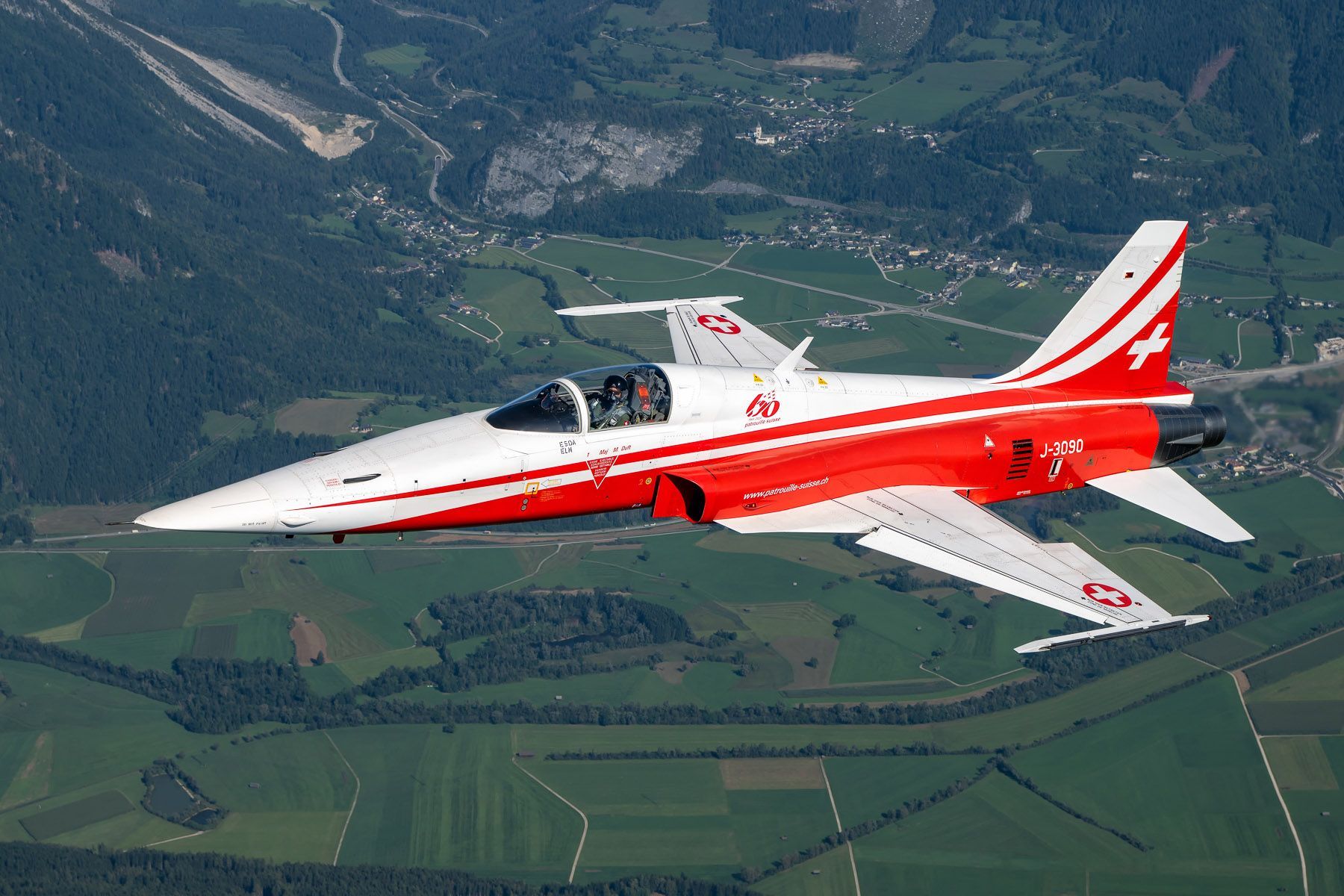
Scratch on long safety record
Safe operation had been achieved for more than half a century, until a nasty incident occurred on 9 June 2016. During a rehearsal for the Royal Netherlands Air Force Open Days at Leeuwarden, the numbers two and three collided while rejoining formation. The pilot in the number three aircraft (J-3086) came in with higher speed than anticipated, and while slowing down he briefly lost sight on the number two (J-3088). Now flying a bit slower than the one to follow, the left wingtip of his aircraft hit the underside of the right wing of number two, causing a large scratch and a punctured right-hand flap. While continuing aft, the left aileron of number three cut off a large part of number two’s right horizontal stabilizer. As a result, the damage to number three’s left wing was to such an extend that the aircraft became uncontrollable and the pilot had no choice but to bail out. Both the pilot and his ejection seat ended up in a glass house, slightly injuring the pilot. The aircraft itself crashed in small pond just aside from that greenhouse and was destroyed, the wreck being salvaged a few days later for the post-crash investigation. The pilot of the J-3088 steered his aircraft towards the nearby North Sea and although significantly damaged, he assessed his aircraft as still being controllable and subsequently executed an emergency landing at Leeuwarden. After extensive repairs, the aircraft was ferried back to Switzerland on 23 September 2016.
After thorough investigation of the mishap, the Dutch Safety Board mentioned the loss of visual contact as main cause. They also pointed out a few factors that may have contributed. First, Patrouille Suisse pilots are only part-time performers, as they are all assigned to regular jet fighter squadrons, contrary to most other well-known demo teams. Second, most team pilots mainly flew the air force’s F/A-18 Hornets at that stage. Flying the F-5 only in relation to Patrouille Suisse was cited as a possible reason for a degraded proficiency on the latter type. In the Hunter and early Tiger days, with these being the main types in service back then, this was never a factor. Although the display at Leeuwarden was cancelled for obvious reasons, the team picked up their routine a few days later for a national performance.
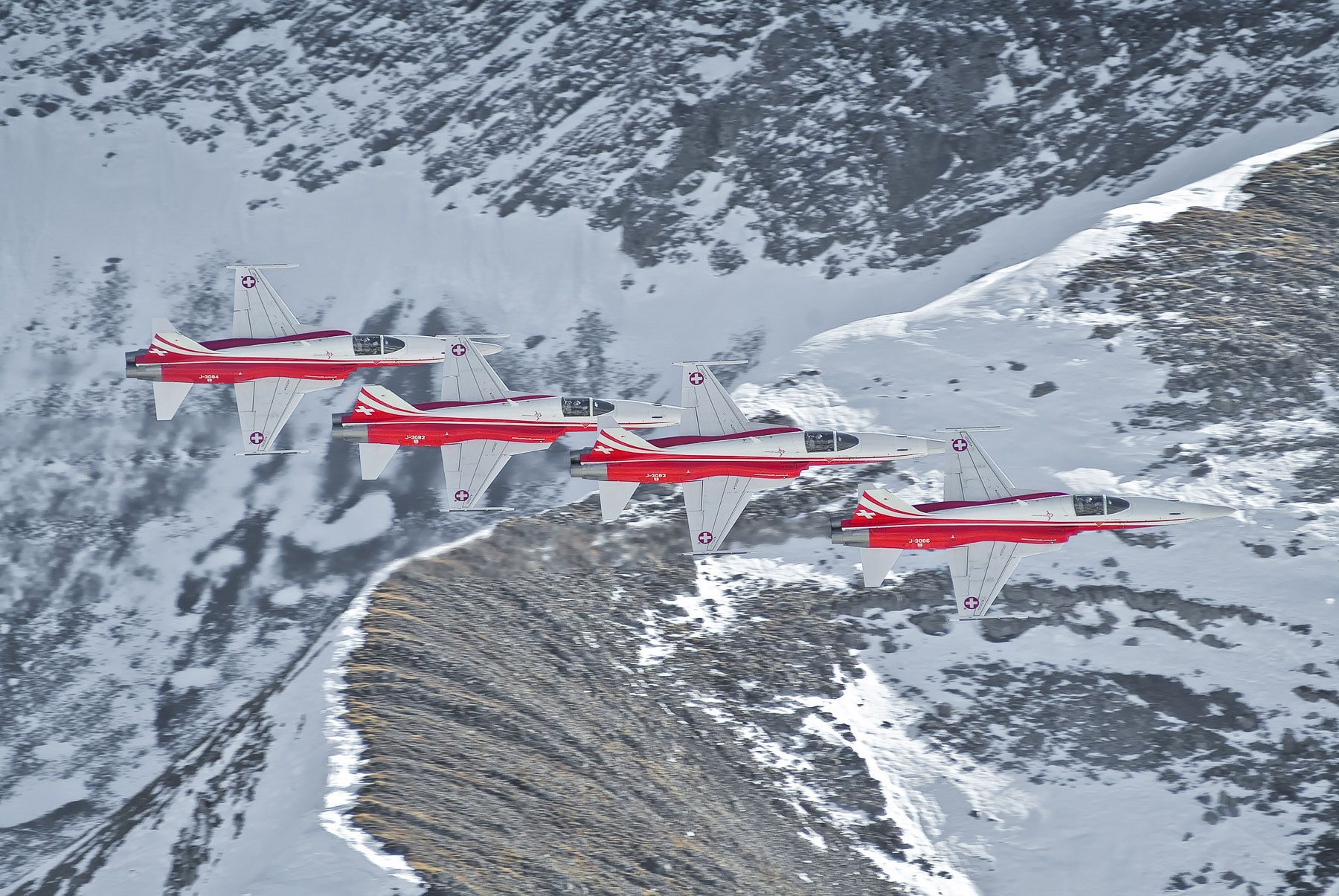
Ups and downs
In 2017, Patrouille Suisse was presented the Aero-Suisse Award by the Association for Swiss Aviation, for being an ambassador for the country as well as amplifying the positive image of the air force. The worldwide Covid-19 pandemic forced the team to cancel the entire 2020 season, a first in the team’s history. The next year, Patrouille Suiisereturned to the skies albeit on a reduced scale.
While not related to the team, one of their assigned aircraft (J-3089) had to be written off following a crash on 26 May 2021 on a mountain near Melchsee-Frutt in Obwalden. Its pilot had taken off from Payerne for a 2-vs-1 air combat mission and fortunately ejected successfully. The aircraft involved was one of two without the smoke system installed.
On 15 June 2023, Patrouille Suisse was involved in another in-flight incident while training their programme over Baar in Central Switzerland. With four aircraft flying in line astern, the number two made a sudden downward move, slightly touching the number three resulting in a damaged nose cone as well as the loss of the drag-chute. Both pilots managed to safely land their aircraft (possibly J-3081 and J-3085, though unconfirmed) at Emmen. The same year also had a highlight, as Patrouille Suisse attended the 70th anniversary at Salon-de-Provence of their Patrouille de France neighbour team.

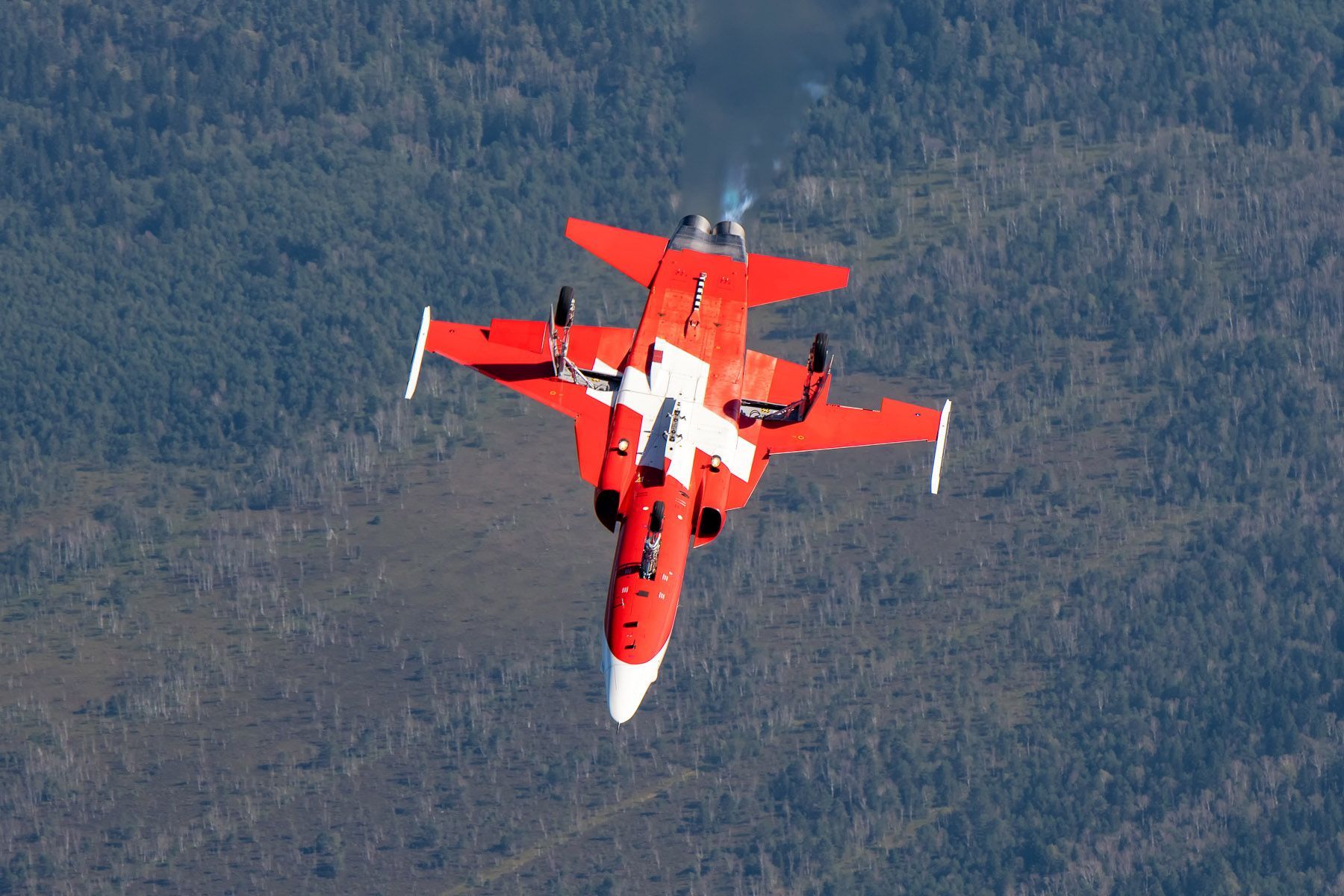
Anniversary or the end?
And then, Patrouille Suisse prepared for their own anniversary in 2024. A large event was planned to celebrate this, but as mentioned at the start of this article, the Airspirit 24 to be held in August at home base Emmen was cancelled because according to the Swiss air force, their budget did not allow it. Also the annual two-day show over the Axalp shooting range held every October was cancelled for the same reason. During the RIAT 2024 at RAF Fairford, the team was once again presented the King Hussein Memorial Sword for best performance. Certainly a big achievement, however displaying their skills for a home audience in their anniversary year would have been the icing on the cake.
The 2024 season ended on 31 October with a display over Meiringen during the annual report presented by the Swiss air force commander, Divisionär (Major General) Peter Merz. The future for Patrouille Suisse is obscured by clouds. According current plans, the small remaining F-5 fleet consisting of 18 F-5E/Fs with seven more in storage as reserve will be retired by the end of 2027. From 2028 the Lockheed-Martin F-35A Lightning II will enter service, and the Swiss air force has indicated that it can not afford to maintain three different types of jet fighters simultaneously especially since there is no longer an operational need for the Tigers.
Patrouille Suisse had faced the axe before. In 2013, defence minister Ueli Maurer stated there would be no jets available anymore for formation display purposes as per 2016. Then the plan to acquire Saab Gripens to replace the Tigers fell through and the F-5 would have to soldier on for a few more years, securing some extra time for the demo team. In 2022, it was planned to withdraw the Tiger from service in 2025 but again this was postponed, this time to late 2027.
Air force commander Merz has expressed that it is intended to continue flight demonstrations after 2027. However, it that will be the case, Patrouille Suisse will no longer operate jets and some kind of merge with the air force’s well-known PC-7 Team could be a viable option.
Anyway, let’s hope the future for Patrouille Suisse will be secured in one way or the other. If not, the lasting memories and images will remind us on their great past performances. And if that’s not enough, there is a Patrouille Suisse Square at Emmen as a memorial, while two retired F-5Es (J-3056 at the Verkehrshaus der Schweiz or Transport Museum in Lucerne, and the J-3096 disguised as J-3013 at the Flieger Flab Museum at Dübendorf) are both painted in the team colours to celebrate the golden era. ■

The people
Of course, there would be no Patrouille Suisse without people. The formation can only function with dedicated and skilled team members, not only pilots but also the maintainers keeping the aircraft fit for flight, the speakers enjoying the crowds, and everyone behind the scenes to make the team work. Over the last sixty years, many have contributed. Highly appreciating the efforts of all of them, I would like to pick out a few.
During the 1983 and 1984 seasons, Lieutenant Fredi ‘Rämsi’ Ramseier flew the number three slot, and subsequently was the team’s number 6 in 1985 and number 5 in 1986 and 1987. From 1988 until 1995 he lead the team in both the last Hunter and the very first Tiger season. After leaving the team, he continued flying F-5s, ultimately commanding the Ausbildungs- und Dienststaffel 16 at Dübendorf. In this role, I (the author) had the pleasure of meeting him in 2003, as he took me up for a ride in an F-5F for an air-to-air photo sortie on a formation of Tigers. I’ll always appreciate his tips and tricks as these have undoubtedly enhanced my skills as an air-to-air photographer. Meeting him again a few years later prior an air-to-air photo sortie with PC-7s, I’ll never forget that he was quite impressed by my preflight briefing, though he probably didn’t realise that it was he who had put me on the right track earlier. Thank you Rämsi.

If you are talking about Patrouille Suisse, there is one guy that can’t remain without mention. Hauptmann (Captain) Daniel ‘Dani’ Hösli joined the team in 1987, filling the number 2 slot for three years. Then he became the number 5 during 1990-1991, number 6 for the next four years, and continued as leader for the 1996 and 1997 seasons, taking over the position from Rämsi. In 2001, he returned to the team in the role as number 0, the team commander and manager, supervising the training and actual displays from the ground. Dani, now promoted to Lieutenant-Colonel, would fulfil this job for no less than fifteen years until finally retiring in 2015. Over the years, he had become the face of Patrouille Suisse and like Rämsi, I had the great pleasure of meeting him in relation to some air-to-air photography back in 2003. I pictured him in a PC-6 on our way from Dübendorf to Mollis while flying in an Alouette III helicopter. After a coffee break we returned back to Dübendorf, now joining Dani in the PC-6. With the pictures of the Alouette taken, Dani allowed me to take the right seat and handed me the controls. As such, I did the landing on the grass strip. It was an extremely short landing run; I’ll withhold the details but we both had a great laugh. After lunch we continued with a great PC-9 photo flight. Great guy and professional, feel privileged to have worked with him.
